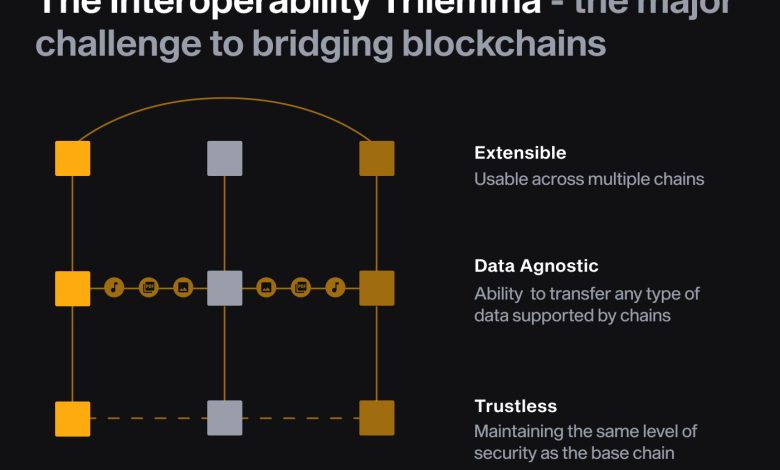Blockchain Interoperability: Challenges and Solutions

- Understanding Blockchain Interoperability
- The Importance of Interoperability in Blockchain Technology
- Challenges Faced in Achieving Blockchain Interoperability
- Exploring Solutions for Seamless Blockchain Integration
- Key Technologies Driving Blockchain Interoperability
- Future Outlook: Advancements in Blockchain Interoperability
Understanding Blockchain Interoperability
Blockchain interoperability refers to the ability of different blockchain networks to communicate and share information with each other. This is crucial for the widespread adoption of blockchain technology as it allows for seamless transactions and data transfer between various platforms.
One of the main challenges in achieving blockchain interoperability is the lack of standardization across different networks. Each blockchain has its own set of rules and protocols, making it difficult for them to interact with one another. However, there are several solutions being developed to address this issue and improve interoperability.
One approach to achieving blockchain interoperability is through the use of cross-chain communication protocols. These protocols act as bridges between different blockchains, allowing them to exchange information and assets. Examples of cross-chain communication protocols include Polkadot, Cosmos, and Aion, which aim to create a connected ecosystem of blockchains.
Another solution to the interoperability challenge is the development of interoperability layers or middleware. These layers sit on top of existing blockchains and provide a standardized interface for communication. By using interoperability layers, developers can build applications that can interact with multiple blockchains without having to understand the intricacies of each network.
Overall, blockchain interoperability is essential for the growth and evolution of the technology. By enabling seamless communication between different networks, interoperability opens up new possibilities for innovation and collaboration in the blockchain space. As the industry continues to mature, we can expect to see more advancements in interoperability solutions that will further enhance the capabilities of blockchain technology.
The Importance of Interoperability in Blockchain Technology
Interoperability in blockchain technology is crucial for the seamless exchange of data and assets across different blockchain networks. It allows for increased connectivity and collaboration between various blockchain platforms, enabling them to communicate and interact with each other effectively.
One of the key benefits of interoperability is the ability to transfer assets and information between different blockchains without the need for intermediaries. This not only reduces costs and transaction times but also enhances security and transparency in the process.
Furthermore, interoperability promotes innovation and scalability in the blockchain space by allowing developers to build on existing networks and create new applications that can interact with multiple blockchains. This fosters a more dynamic and diverse ecosystem that can adapt to the evolving needs of users and businesses.
Overall, interoperability plays a vital role in unlocking the full potential of blockchain technology by breaking down silos and enabling seamless communication between disparate networks. As the blockchain industry continues to grow and evolve, achieving greater interoperability will be essential for driving widespread adoption and realizing the transformative power of this revolutionary technology.
Challenges Faced in Achieving Blockchain Interoperability
One of the main challenges faced in achieving blockchain interoperability is the lack of standardization across different blockchain platforms. Each blockchain network has its own set of protocols and consensus mechanisms, making it difficult for them to communicate with each other seamlessly. This lack of compatibility hinders the interoperability of blockchains and limits their potential for widespread adoption.
Another obstacle to blockchain interoperability is the issue of scalability. As blockchains continue to grow in size and complexity, the network congestion and transaction fees increase, making it harder for blockchains to interact with each other efficiently. This scalability challenge must be addressed to ensure smooth interoperability between blockchain networks.
Moreover, the security and privacy concerns associated with blockchain technology pose significant hurdles to achieving interoperability. Ensuring that data shared between blockchains remains secure and private is crucial for building trust among network participants. Security measures must be implemented to protect transactions and information exchanged between blockchain platforms.
Exploring Solutions for Seamless Blockchain Integration
When it comes to seamless integration of blockchain technology, there are several solutions that can be explored to address the challenges of interoperability. One approach is the use of cross-chain communication protocols, which allow different blockchains to communicate and share data with each other. This can help in creating a more interconnected ecosystem where transactions can flow smoothly between different blockchain networks.
Another solution is the development of interoperability standards that can be adopted by various blockchain platforms. By establishing common protocols and guidelines, it becomes easier for different blockchains to interact and exchange information in a standardized manner. This can help in reducing the complexity of integrating multiple blockchain networks and ensure a more efficient flow of data and transactions.
Furthermore, the use of sidechains and off-chain solutions can also contribute to seamless blockchain integration. Sidechains allow for the creation of parallel blockchains that can interact with the main blockchain, enabling scalability and improved performance. Off-chain solutions, such as state channels and payment channels, can help in reducing the burden on the main blockchain by enabling faster and more cost-effective transactions.
Key Technologies Driving Blockchain Interoperability
Several key technologies are driving blockchain interoperability, enabling different blockchain networks to communicate and share data seamlessly. These technologies play a crucial role in addressing the challenges associated with interoperability in the blockchain space.
- Atomic Swaps: Atomic swaps allow for the trustless exchange of cryptocurrencies across different blockchains without the need for intermediaries. This technology ensures that transactions occur simultaneously or not at all, reducing the risk of one party failing to fulfill their end of the bargain.
- Sidechains: Sidechains are separate blockchains that are interoperable with a primary blockchain, allowing for the transfer of assets between the two chains. This technology helps in scaling the blockchain network by offloading transactions onto sidechains, thereby reducing congestion on the main chain.
- Interoperability Protocols: Interoperability protocols such as Polkadot and Cosmos provide frameworks for different blockchains to connect and communicate with each other. These protocols establish standards for cross-chain transactions, ensuring compatibility and seamless interaction between disparate blockchain networks.
- Cross-Chain Bridges: Cross-chain bridges act as connectors between different blockchains, facilitating the transfer of assets and data across disparate networks. These bridges help in establishing trustless communication between blockchains, enabling users to access services and assets from multiple chains seamlessly.
By leveraging these key technologies, blockchain interoperability is becoming increasingly achievable, paving the way for a more connected and efficient blockchain ecosystem. As the blockchain industry continues to evolve, the development and adoption of interoperability solutions will play a vital role in unlocking the full potential of decentralized technologies.
Future Outlook: Advancements in Blockchain Interoperability
Looking ahead, the future of blockchain interoperability appears promising as advancements continue to be made in this field. These advancements are crucial for overcoming the challenges that currently exist and for enabling different blockchain networks to communicate and interact seamlessly with each other.
One of the key areas of focus for future developments in blockchain interoperability is the creation of standardized protocols that can be adopted by multiple blockchain platforms. By establishing common standards, it will be easier for different networks to connect and share information, ultimately leading to a more interconnected and efficient blockchain ecosystem.
Another important aspect of future advancements in blockchain interoperability is the development of cross-chain communication technologies. These technologies will allow for the transfer of assets and data between different blockchains, opening up new possibilities for decentralized applications and smart contracts that span multiple networks.
Furthermore, ongoing research and innovation in the field of blockchain interoperability are leading to the emergence of new solutions that address the scalability and security issues associated with cross-chain transactions. By leveraging techniques such as sidechains, atomic swaps, and state channels, developers are finding ways to enhance the interoperability of blockchain networks while maintaining high levels of performance and security.
In conclusion, the future outlook for advancements in blockchain interoperability is bright, with continued progress being made towards creating a more connected and efficient blockchain ecosystem. By addressing the challenges and implementing innovative solutions, the potential for blockchain technology to revolutionize various industries and applications is becoming increasingly apparent.






